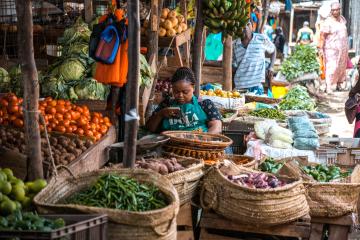
Evidence for digital and bundled services: Framing a research agenda for the Digital Agricultural Innovations and Services Initiative

In December 2021, we announced the launch of the Digital Agricultural Innovations and Services Initiative (DAISI), jointly managed by J-PAL and UC Berkeley’s Center for Effective Global Action (CEGA) and supported by the Bill & Melinda Gates Foundation. Chaired by Jennifer Burney (UC San Diego), Robert Darko Osei (University of Ghana), and Tavneet Suri (MIT), DAISI supports innovative, policy-relevant research on the availability, quality, and reach of bundled digital agricultural solutions and services for small-scale agricultural producers.
As the reach of digital agricultural services has grown rapidly within the last few years, building an evidence base on how they should be designed, implemented, and scaled to best align with the priorities of small-scale producers is an important and timely issue—and one that DAISI is well-positioned to address.
After months of research, conversations, and brainstorming, we are launching a robust research agenda that will guide DAISI’s activities and investments over the next few years.
What are digital and bundled services?
Digital:
Digital services are platforms and solutions that leverage digital hardware and/or software to deploy agricultural services for farmers, middlemen, co-ops, and other actors to improve their access to information, financial services, markets, or equipment/machines, among others, for use in agricultural activities.
When we think of digital agricultural services under DAISI, we categorize them into two tracks:
Fully digital, where all services are delivered through a digital technology, or hybrid, where there is partial digitally-enabled delivery of at least one service in a package of services (e.g., text message reminders for timely information during planting followed by in-person field visits by a government extension agent before harvest).
Bundles:
Farmers face a myriad of constraints to adopting new technologies that increase agricultural productivity and farmer welfare, like access to credit, savings, inputs, information, infrastructure, institutions, externalities, risk, labor, land, and gender-specific barriers. Alleviating any one of these constraints can help improve the adoption of technologies, but research has shown that increases in adoption from alleviating any single constraint seem to be quite small.
Under DAISI, a bundled program should connect farmers to agricultural services or products that simultaneously relax two or more constraints they face. When characterizing services as a bundle, we consider the number of constraints targeted by the service rather than the mechanism or structure of the service itself.
Framing an agenda: Key themes and questions
DAISI’s research agenda features six main topics with three cross-cutting themes: gender, youth, and climate resilience.
Priority theme 1: Uptake and use of digital and bundled services in agriculture
Digitalizing agricultural services creates opportunities for bundling because of the possibility of reducing implementation and delivery costs while also expanding the reach of the program. Building an evidence base on what types of bundles are most effective in alleviating binding constraints, and how they are effective, will be critical to realizing the full potential of digitalization and bundling.
An important part of this process is gaining an understanding of which bundles farmers and other actors in an agricultural value chain are willing to adopt, and why. For example, what models of integrated or bundled digital and non-digital services drive high rates of adoption and use of agricultural technologies by small-scale producers? Or, do incentives impact the take-up and use of bundled and digital services?
Priority theme 2: Impacts of digital and bundled services on agricultural outcomes
When discussing the effectiveness of bundled, digitally-enabled agricultural services, we consider and encourage researchers to address a range of outcomes: agricultural productivity, agricultural production and profitability, farmer welfare, expansion of opportunities for women and women’s empowerment, and resilience to both extreme weather shocks and longer-run climate and environmental changes.
DAISI will prioritize evaluations that address whether and how bundled and digital services contribute to improved agricultural outcomes. For example, which bundles are most effective at relieving constraints and for which farmers, providers, or agents in a value chain? Or, how cost-effective is the bundle relative to the individual components?
Priority theme 3: Factors that affect how bundles perform relative to their individual components
Little to no rigorous evidence exists to show how bundles of agricultural services perform relative to individual components that make up the bundles.
In theory, there are various reasons to expect that bundles may be more effective than the individual components themselves; in addition to their focus on multiple constraints, there could be strong complementarities (in terms of the benefits to the farmer) among the different components of a bundle that may lead to outsized impacts. Moreover, if the services are digital, a common platform could lower the users’ costs of accessing and learning about the components of the bundle.
DAISI is, therefore, interested in understanding how these complementarities of bundling and digitalization interact to impact agricultural outcomes. For example, what factors facilitate the take-up and use of bundled services relative to the individual components? Or, does the use of one service on a platform incentivize the use of other services available on the same platform for an individual user?
Priority theme 4: Bundled platform externalities, general equilibrium effects, and spillovers
While DAISI will fund research to examine the direct effects of bundled and digital services, we are also interested in capturing and assessing any unforeseen impacts of these programs on people and markets that are not receiving the service directly—spillovers, externalities, or general equilibrium effects. Some examples of these effects would be information transfer from participating farmers to neighboring farmers, learning externalities as a result of technology adoption, or market-level changes in credit provision as a result of a cash transfer or mobile money platform, respectively.
There has been little research on this in low- and middle-income economies, especially in agriculture, so DAISI encourages cross-discipline research partnerships to study these effects. For example, does the use of one (or multiple) service(s) on a platform incentivize other users in the household or community? Or, does one service serve as an on-ramp for access and use of other non-agricultural services (e.g., the expansion of mobile money creating opportunities for other digital services)?
Priority theme 5: How bundles or agricultural services can be most effective in addressing gender-specific constraints
While gender is also a cross-cutting theme to be considered (see below for more), there are substantial opportunities to design and evaluate programs that target women and dive deeper into the dynamics that affect women in agricultural value chains. Specifically, women farmers face constraints that men farmers in their same communities do not, ranging from differential access to inputs and information to decision-making barriers around production and profit use. Gender is often incorporated into analysis after an evaluation is complete, primarily by estimating impacts based on gender of the household head. However, DAISI will prioritize research that takes a structural and intentional approach to gender in both design and implementation.
For example, will the bundle relax constraints uniquely faced by women farmers to allow them access to higher productivity technologies and ultimately improve their empowerment and livelihoods? Or, are there specific combinations of services that, when offered together, have a greater likelihood of unlocking barriers and constraints for women, particularly women who seek to be more integrated into commercial agricultural markets?
Priority theme 6: Enabling a conducive environment for innovation, scaling, and sustainability of bundled and digital agricultural services
To scale appropriately and effectively, policymakers and researchers must account for local conditions and implementation capacity, and then adapt programs to that new context accordingly. Scaling can include increasing the reach of an existing program in the same context; innovating, replicating, and expanding a successful evaluated program to similar contexts; or innovating, testing, and reassessing a program that was evaluated and found to be ineffective or not cost-effective.
Given the potential of digitalization to scale programs across geographies, DAISI will encourage researchers to apply for path-to-scale grants as well as consider scale and sustainability of programs in randomized evaluations of existing services and bundles. For example, what are the feasible business models for service provision to replicate and cost-effectively scale these services? Or, can the digital reach of the bundled interventions lower the costs enough to effectively reach farmers at scale?
Cross-cutting themes: Gender, youth, and resource use and climate resilience
DAISI’s cross-cutting themes highlight an opportunity to generate research with previously understudied groups or of understudied topics. For example, agricultural gains for women and youth farmers in sub-Saharan Africa represent untapped potential for digital, bundled services since youth make up about 60 percent of the population and agriculture is the main livelihood for women, though their productivity lags behind that of men’s. Similarly, agriculture and resource use are intertwined, so building farmers’ resilience to weather-based shocks and climate change will be critical to ensuring farmer welfare as well as agricultural productivity and sustainability.
DAISI encourages researchers applying for funding to speak to at least one of these themes in their study. For example, what role do bundled digital services play in improving women’s welfare and empowerment? Through what channels are these impacts realized? How engaged are youth with bundled, digital agricultural services and platforms as entrepreneurs? Does the bundle result in land use or land cover change? Does the bundle change the impact of a climate shock on the production system or farmer welfare?
Through these thematic areas and open questions, DAISI will generate a rigorous evidence base on the impact of digital tools and bundled approaches on improving small-scale farmers’ outcomes, bolstering farmers’ resilience to climate change, connecting farmers to markets, and expanding commercialization in sub-Saharan Africa and South Asia.
What comes next?
Through strong partnerships between researchers, the private sector, service providers, and policymakers, DAISI will address outstanding questions, help providers to evaluate their services and models, and share results relevant to policy and practice in sub-Saharan Africa and South Asia. DAISI’s first call for research proposals opens today, July 14, 2022. Researchers in the J-PAL and CEGA networks are eligible and invited to apply. Learn more about the competition, grant types, eligibility, and guidelines.
For interested resident African and South Asian scholars, learn more about DAISI's Regional Scholars program, eligibility, proposal types, and guidelines for submission.
If you are interested in partnering with DAISI to evaluate your bundled program, digital service, and/or business model, please contact us at daisi [at] povertyactionlab [dot] org.



